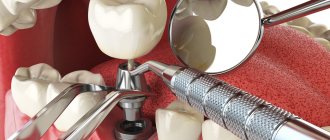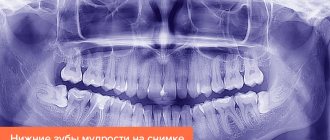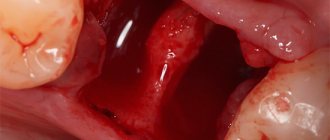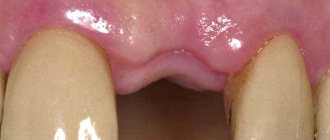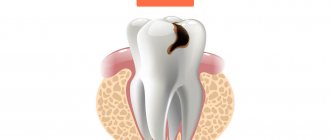Almost every person who seeks help from a dentist would like to know how long it takes to treat teeth. After all, some are in a hurry to get to work, some need to look after their children, and for others, bad teeth prevent them from fully enjoying their vacation or going on a business trip. And in any case, staying in a dentist’s office, even with the most innovative and painless treatment methods, can hardly be called a comfortable pastime.
No one can answer this completely natural and relevant question for the patient - after all, dental treatment is an individual procedure and it is extremely difficult, and in some cases simply impossible, to predict its duration in advance with a certain accuracy. Even the treatment of simple caries can take 15-20 minutes, or can be extended over more than one visit, depending on the depth of the tooth damage. High-quality treatment, for example, for periodontitis or caries complicated by pulpitis, requires at least 2 visits to the dentist’s office.
Therefore, when assuming how long dental treatment will take, you must keep in mind that the dentist, when determining the tactics of the procedure, must take into account the general health of the patient, and not just his teeth, the possible presence of allergic reactions, etc. Each specific case requires an individual approach. Thus, when treating caries on two teeth located nearby, filling them is not carried out simultaneously, but first one, and during the next visit - the second. Sometimes, to avoid confusion in treatment, it is performed alternately on the right and left sides, which allows the patient to reliably determine which tooth caused the pain. All this, naturally, requires additional time.
When planning your visit to the dentist and determining how much dental treatment is required, you should also take into account the cost of anesthetics (nowadays, few people risk being treated without anesthesia). And if the front teeth are subject to repair, then you must immediately be prepared for the fact that the procedure may be delayed, because it will require the expert work of a specialist. Practice shows that on average, during a one-time visit, you will have to spend 30 minutes to an hour in the dental chair.
It’s worth talking especially about how much teeth are treated
during prosthetics. This procedure is not easy, and it will not be possible to get by with just one visit to the doctor. It will require an examination, photographs, and consultation with a dentist about choosing a prosthetic option. In some cases, at the preparatory stage the patient will have to undergo a more detailed examination. The process of prosthetics itself will take a lot of time. At the first stage, the supporting teeth are prepared for installation of the prosthesis, the oral cavity is sanitized, and high-quality impressions are made of both jaws. Depending on many factors, the first stage can be carried out over a period of several days to one to two weeks.
The second stage, which consists in manufacturing the required design of a removable or fixed prosthesis in a dental laboratory, will also take a lot of time. Then, during the third stage, the finished prosthesis is attached to the patient’s teeth. This is preceded by fitting and fitting. The duration of each stage varies over a fairly wide time range, so even an experienced dentist can only roughly tell the patient how long teeth will be treated through prosthetics.
The implantation process is even longer. Regardless of how classical the technique used is, it is preceded by a thorough and comprehensive assessment of the patient’s condition, including not only radiography and the use of other imaging methods to identify the anatomical features of the oral cavity, but also examination of other organs and systems, blood tests, etc. d. Considering the treatment of the oral cavity (and other organs) prescribed if necessary, the preparatory stage can take quite a long time. But even after it has been carried out, no one can say reliably how much teeth are treated.
Depending on whether immediate, delayed or late implantation is carried out when a denture is installed - with immediate, early or delayed loading, a considerable number of other associated factors, the entire implantation process will take from 3 to 6 months, and sometimes more. True, some concepts of surgical dentistry involve installing implants and fixing permanent dentures on them within one day (exclusively in cases of edentulous (toothless) jaws.
With all the variety of factors influencing the duration of the procedures, how long teeth are treated largely depends on the professionalism of the staff of a particular dental clinic. The presence of modern equipment in the medical institution and the use of innovative materials also play a significant role in reducing the duration of the entire treatment, reducing the number of visits to the doctor, and minimizing the risk of possible complications.
Read also: How to eliminate toothache at home
Project manager Reiter D.V.
Our clinic is a high-level dental center with the best international class equipment. We attract only leading specialists in several areas.
Types of anesthesia
Dental anesthesia can be local, general, medicinal and non-medicinal. The latter type is used very rarely. These are hypnosis, audio analgesia and electroanalgesia.
Dental anesthesia blocks pain impulses. Due to this, there is a temporary loss of sensitivity of individual tissues. After some time, the drug is removed from the body and the sensitivity of the surgical site is restored.
General anesthesia is rarely used. The main indication for the procedure is considered to be poor tolerance of local agents and an extensive list of dental work. Usually, local anesthesia is chosen, when an anesthetic is injected into the treated area. This method of pain relief is used for adults and children.
Types of local anesthesia
Local dental anesthesia is of the following types:
- Application. The procedure freezes the surface layer of tissue. For this purpose, creams and a spray with “Lidocaine 10%” are applied to the gums. The application is performed before the injection. This will make the procedure less painful. Application anesthesia is used to treat stomatitis, gingivitis and other infectious diseases of the oral mucosa.
- Infiltration. The main difference of this method is considered to be a gentle effect. With the help of infiltration anesthesia, loss of sensitivity in a limited area occurs. The method is used during the treatment of teeth in the upper jaw, since the drug is distributed more efficiently in these structures.
- Provodnikova. Anesthesia is designed to freeze large areas. This type of anesthesia is required to cause loss of sensation in several elements located far from each other. It is used for pulpitis, complex caries, opening of purulent capsules, periodontitis. After administration of the drug, loss of sensitivity of the entire nerve bundle of the area occurs.
- Intraligamentary. The method is used in pediatric dentistry. The drug is injected into the space between the alveolus and the root of the tooth. The mucous membranes do not lose sensitivity.
- Stem. The procedure is performed in a hospital. It is required for injuries of the maxillofacial apparatus, neuralgic pain. The injection is made at the base of the skull bones to ensure loss of sensitivity in both jaws. Pain relief lasts longer and is more effective than other types of anesthesia.
- Intraosseous. This type of tooth anesthesia is required when removing it. It is performed in several stages. First, an anesthetic is injected into the gums and then into the jawbone. The freezing effect appears faster compared to other types of anesthesia.
Are teeth treated with anesthesia? For most dental diseases, this procedure is mandatory in order to alleviate the person’s condition. The doctor must decide which type of pain relief to choose.
ᐉ Teeth fillings and their photos - installation stages and how long after filling you can eat
The history of fillings goes back centuries. After all, caries is a very old problem and they tried to fight it in different ways - until they learned how to handle the soft metal lead. The word “filling” itself comes from the Latin “plumbum” (lead). Of course, modern technologies have gone far ahead, and the need for toxic lead has disappeared completely, but the term remains.
When a patient comes to the dentist, he cannot observe the treatment from the outside. Maximum - at the end of the appointment, the doctor will give a mirror so that the patient can admire the restored tooth. But patients are very interested in how the process happens.
Therefore, in today’s material we will lift the veil of secrecy and answer in detail the questions - why and how to put a filling on a tooth, what materials are better and for which teeth, how much should you not eat after filling? Read the article and find out everything.
When and why is tooth filling necessary?
Why is a filling placed on a tooth?
Why do they put fillings? The structural features of dental tissues are such that they cannot cope with caries on their own. Previously, there was only one and radical solution - removing the damaged unit.
But in the middle of the twentieth century, a breakthrough occurred in dentistry - they learned how to remove carious lesions and restore the tooth with filling. Fillings are used in the treatment of caries, pulpitis, and restoration of defects (wedge-shaped, for example).
You can also use a filling preparation to lighten the enamel and restore its shape after it has been chipped.
Is it worth getting a filling? Is it really necessary, or is it just an invention of dentists? Under the hard layer of enamel there is softer and looser dentin and a neurovascular bundle (pulp). But we remember that there are a huge number of bacteria in the human mouth! This means that after opening the enamel, there is a 100% threat of infection of dentin and pulp.
Also, with an open tooth, a person will not be able to eat normally. In the process of chewing food, pain and malocclusion will appear. Injuries and chips of the crown will occur, and the tooth may even break at the root. That is why the question of whether filling is necessary is not even worth asking - it is necessary and mandatory! Otherwise, you may be left without a tooth altogether.
What are the types of filling materials?
In modern dentistry, classification proceeds in 2 directions - by time of use and by material. Let's look at each point in detail.
Classification by time of use
Based on the time of use, there are two types - temporary and permanent.
Temporary fillings
A temporary filling is placed for 2-7 days. Its function is to protect the tooth cavity during treatment so that bacteria do not penetrate inside.
It also holds the drug in place and prevents it from contacting the mucous membranes in the mouth.
And this can lead to irritation, chemical burns or oxidation of the drug with saliva (so it can lose its properties). The use of a temporary form is possible in the treatment of the following diseases:
- caries: the dentist is not sure of the depth of the lesion, so after cleaning the carious tissues, a temporary filling is carried out and the “behavior” of the tooth is monitored for 1-2 days,
- pulpitis: when choosing the devitalizing route, the pulp is killed with a special paste (most often arsenic) - a temporary filling preparation is applied on top of it for 2-3 days. At the same time, the paste “does its job” - that is, it kills the nerve. If the dentist has chosen the vital method, i.e. removal of the living pulp, then after this a medicinal paste is applied (also for 1-2 days), • periodontitis: treatment of this pathology can be lengthy, 1-2 times a week the doctor can change the drug in the root canals and pulp, and the medicinal paste during therapy is covered with temporary material.
The photo shows a temporary filling
Permanent fillings
Permanent ones are placed on a completely cured tooth and for a long time. The dentist usually gives a 1 year warranty, but with proper care it can last 5-10 years or even more. Installing it is more difficult than temporary - it is important to follow the technology correctly (we will return to this point later in the article).
Classification by material
Nowadays, preference is given to modern products - they are less toxic, more wear-resistant and aesthetically pleasing. You can choose a color that is absolutely identical to natural enamel. But first things first.
Composite
This is how light-curing composites are installed
The most commonly used material at present. The composition includes silicates and artificial resins. Hardens quickly (up to 1 hour), sands and polishes well. But in case of large damage to the crown, their use is inappropriate. There are 2 types of composite materials:
- chemical: curing of the components occurs within a few minutes after mixing and placing into the cavity. Due to the difficulty of selecting colors, they are used on the chewing elements of the dentition (premolars and molars),
- light-curing: they are also called “light-cured”. The hardening of the composite occurs under the influence of a special dental lamp. The light-curing material can be easily painted to match the natural color of the enamel.
Cement
The most economical option, but today it is rarely used - most often in pediatric dentistry. They harden for a long time (up to 4 hours), are extremely difficult to grind and have a short service life (6-12 months).
Metal
Metal fillings are made of gold, silver and amalgam (mercury alloy). Metal materials are completely unaesthetic (and amalgam is also very toxic), so they are used very rarely and on the chewing part of the row. Their advantages are excellent wear resistance.
The photo shows a metal filling
Compomer
Compomer materials have been used relatively recently, and not all clinics know how to install them. They performed well in the restoration of minor defects - small chips and superficial caries. Can be used as a component for filling in the “sandwich technique”. The cost of such material is quite high.
Ceramics and porcelain
Such fillings are also called “tabs”. They are durable, resistant to staining with food dyes, and tolerate temperature changes well. Disadvantages include cost and production time (1-2 weeks). They are made individually in the laboratory. After taking the impression, a plaster model is formed, the product is cast and fired.
The photo shows inlays on teeth
Plastic
They were widely used in Soviet times, but now they are not installed almost anywhere. They are toxic, cause allergies, are fragile and quickly darken.
For temporary filling
Almost all materials include zinc oxide or sulfate and several other components.
Depending on the area of application, the dentist may use temporary filling pastes with the addition of clove and sage oils, polystyrene, eugenol, polyacrylic acids and synthetic resins.
The Belokor mixture can be used not only for temporary filling, but also for fixing prosthetic structures to supports and permanent filling of primary occlusion. The “Kariosan” mixture can be used to fill root canals.
Stages of installing a seal
How does a dentist place a filling? Let's understand the standard steps of this process.
Interesting to know! Before the intervention, anesthesia is given so that the patient does not feel pain. But this is not always done. For example, children or pregnant women have a number of contraindications to various drugs - this requires individual selection. You can do without an injection for superficial and medium caries.
- Stage 1: drilling out all carious lesions.
Careful work is needed here, because if you miss even a small outbreak, the infection will develop again. The vitality of the pulp is also checked. If pulpitis is detected, the pulp is removed. At the first stage, teeth are drilled - Stage 2: treatment with an antiseptic. If treatment of pulpitis is necessary, then medicine and a temporary filling are applied,
- Stage 3: isolation of the working surface from saliva.
It is carried out with the application of cotton rolls and air drying. In a number of clinics, even before the first stage, they install a rubber dam - a latex film that is stretched and fixed in the oral cavity. The rubber dam will help protect adjacent teeth and tissues during treatment - Stage 4: installation of a special gasket. It can be insulating (if the base material can harm surrounding tissues) or antimicrobial (so that bacteria do not enter healthy areas),
- Stage 5: application of adhesive and filling material.
If it is light-curing, then activation occurs with a lamp. After formation and hardening, grinding is carried out until the patient feels comfortable closing the jaws. Then the surface is polished. The photo shows the process of installing the seal.
“I went to treat caries; there was severe darkening between the incisors. I thought I would have to get a crown. But the dentist offered me another solution - a light filling. The treatment involved an injection and did not hurt at all.
The dentist shone a special lamp several times to make it stronger. In the end it came out perfect in color and shape. They recommended not to eat anything dyed for a week and not to do any bleaching at all.”
Tatyana K., 27 years old, Stavropol, review from the dentistry.rf forum
Contraindications for installation
When should a filling not be placed? The dentist may refuse installation in the following cases:
- when a very large part of the crown is destroyed: here, to strengthen a unit of the dentition, a pin or stump inlay is installed. In the latter case, the tooth must be covered with an artificial crown,
- you cannot put a filling on top of a filling: over time, even the best filling material loses its properties and sags, that is, high-quality fixation will not work. Such a creation will not last long, and it can also break off in the most unexpected places. Therefore, the old material must be completely replaced,
- in the presence of pulpitis or periodontitis: first you need to cure the diseased tooth and surrounding tissues.
How long does installation take?
How long does it take to place a filling? The whole process, from the moment you arrive at the clinic until you leave it, does not take much time - no more than 1 hour. The dentist may spend more time preparing and processing, or wait for the anesthetic injection to take effect.
Features for anterior teeth
How is filling done on front teeth? There are no special differences from the standard process. But the nuance of correct installation lies in the layer-by-layer application of the composite material and light curing of each layer. For front teeth, it is best to use light-curing polymers with the smallest particles; they provide better aesthetics.
Features for chewing teeth
When filling molar chewing teeth, aesthetics comes second; the ability to withstand loads is more important here. Indeed, at the moment of chewing food, the pressure experienced by the molars can reach up to 70 kg per 1 cm2. Therefore, the use of light-curing composites with large particles or chemically curing composites is justified.
How canals are filled?
Root canals need to be expanded using instruments. The filling material must be moderately fluid so that the smallest pores are clogged.
Gutta-percha pins are also installed - main and additional. Then their tops are cut off. The doctor may prescribe x-ray diagnostics to assess the performance and tightness of the filling.
After the material hardens in the canals, work begins in the coronal part.
This is what gutta-percha points look like
What complications may arise?
Pain for up to three days is normal
The most common complication after filling is pain. Unpleasant sensations may bother a person after the anesthesia wears off. But usually they go away within 2-3 days.
Why is this happening? During dissection, mechanical processing occurred, healthy tissue could be injured, and nearby nerve endings respond with pain.
For a similar problem, tooth sensitivity may persist for several days, weeks or even months.
But if there is severe pain, cutting or shooting in nature, or the filling falls out altogether, it means that the carious tissue was poorly removed or the installation process was disrupted. An urgent visit to the dentist is required.
How much does a filling and installation work cost?
How much does it cost to put a filling on a tooth? The price is formed from several key components:
- dentist's salary,
- quality and volume of material (and anesthesia),
- treatment of concomitant diseases,
- the location of the clinic and its equipment.
If we consider the average cost of composite material and treatment of deep caries (or pulpitis), then it varies between 2000-6500 rubles per 1 tooth.
A temporary filling can be installed for 1000 rubles. If periodontitis treatment is required, then together with filling it will cost 10-12 thousand.
Therapeutic veneers or enamel restoration with composite material starts from 5-6 thousand per tooth.
Rules of care - what dentists recommend
White yogurt will help protect the filling after installation
How long can you not eat after filling? This topic worries most patients. After all, the patient often goes to the appointment on an empty stomach, and after treatment he becomes hungry. In general, dentists advise you to definitely eat something before going to the clinic.
But if this was not possible, then the first meal is possible no earlier than 1 hour after filling. And then, you can only have liquid porridge or light yogurt.
Although modern composites harden well during operation, it is still worth being on the safe side so that microcracks and shrinkage of the material do not occur.
General recommendations are as follows: you can drink water (after 1 hour), you can eat after 2-3 hours. For the first week, we exclude absolutely everything coloring from the diet - this is called the “white diet.” Berries and juices from them, coffee, wine, beets, ketchup, and tobacco are prohibited.
Each type of filling has its own recommendations - the dentist will tell you after the appointment how to properly care for them.
But absolutely all professionals are convinced that chewing gum is dangerous for treated teeth, so they should be abandoned.
Action
Local anesthesia involves injecting an anesthetic with a syringe. The procedure allows you to reduce the sensitivity of a certain area where dental manipulation will be performed.
The active ingredients block impulses that are transmitted to the brain using nerve endings. But the person will be conscious and will not feel pain even during surgery. This only causes a numb sensation in the area where the product was injected.
Advantages and disadvantages
The advantage of local anesthesia is the absence of pain during the procedure. This anesthesia lasts 1-2 hours, which is suitable for performing a small amount of dental work. One of the advantages of this anesthesia is that it is suitable for pregnant women, as well as for diseases of the heart and blood vessels. For this purpose, special means are used, for example, Articaine. Another advantage is convenience for the patient and the doctor. But it is important to consider that there may be allergic reactions to painkiller injections. Therefore, the patient needs to know what drugs he is allergic to.
The disadvantages include the presence of contraindications. Local anesthesia is prohibited for diabetes and renal failure. The downside is the short exposure time, especially if the procedure is serious. If the dentist cannot complete all the work during the period of action of the drug, then it is necessary to postpone the work until the next appointment, since the secondary administration of the medication is dangerous to health.
Types and stages of dental removal
To understand how long it takes to pull out a tooth , you should know the main stages of this procedure:
- Anesthesia. There are 2 types of it: general - eliminates pain, puts the patient into a state of sleep (it is injected intravenously into the hand or arm), local (injection) - removes pain only in the area of the operation.
- Delete. Using forceps, the specialist grabs the tooth and begins to gently rock it to the sides. Thus, the ligaments that hold the dental unit are torn. After tearing it out, a hole is formed, where a tampon with a special solution is placed. In some cases, gum suturing may be required.
- Period after removal. If the blood flows heavily, the tampon will need to be changed every 20-30 minutes. If everything is fine, then it is left for 2-3 hours.
It is worth noting that removal can be simple or complex. The first involves the following steps: local anesthesia, separation of gum tissue, tooth extraction using forceps. Complex extraction may be required if there is a cyst, tumor, severely crooked teeth, or grade 3 and 4 periodontitis.
In any case, patients wonder how long it takes to pull out a tooth . This procedure usually takes about 20-25 minutes. It may take longer if the tooth is firmly seated.
If the removal was carried out without medical errors and with high quality, then the edges of the gums should heal in 2-2.5 weeks. It takes about 10 days for the soft tissue around the hole to heal. It takes up to 8 months to form bone tissue (makes the jaw dense). At this time, unpleasant symptoms no longer bother the person.
Important! The removal procedure is not recommended for diseases of the endocrine system, pregnancy (first, third trimesters), chronic diseases of the circulatory system, and diseases of the nervous system.
Features of the procedure
Regardless of how long the tooth was removed , at the end of this procedure it is not recommended to eat very cold or very hot food, rinse your mouth (then the hole will take longer to heal), stay in the cold for a long time, or touch the wound with your tongue. The healing process will occur much faster if you properly care for the hole.
Important! If any problems arise, you must quickly visit the dental office.
We are talking about the following symptoms: severe pain, swelling, redness, signs of infection (chills, fever), severe bleeding, chest pain and others. Many people are interested in the cost of the removal procedure. It is impossible to give a definite answer, since everything depends on the type of tooth, the individual characteristics of the patient, and the complexity of the operation. The price is also influenced by the qualifications of the doctor and the prestige of the clinic. But you shouldn’t save on this service, so as not to risk your health and not overpay twice.
You can find out more information about how long it takes to pull out a tooth and how the operation takes place on the information portal https://stom-info.ru/.
Indications
Is it possible to treat teeth with anesthesia? This procedure is necessary when:
- treatment of medium and deep caries;
- pulp removal;
- performing surgical interventions;
- implantation of prostheses;
- installation of certain orthodontic devices.
Do they perform dental anesthesia for superficial caries? In this case, anesthesia can also be used. The enamel and dentin layer are sensitive areas, so pain during drilling is often felt.
If you were very stressed before visiting the dentist, it is advisable to take a sedative at night - valerian extract or Afobazole. It is advisable to postpone dental treatment in case of weakness associated with ARVI. It is not advisable to perform dental procedures during menstruation. At this time, strong nervous excitability appears. In addition, surgical intervention during “critical days” can lead to prolonged bleeding.
How long does it take to treat tooth pulpitis?
Author: Brodsky Sergey Evgenievich Deputy Chief Physician, Candidate of Medical Sciences in the specialties: dentistry and medical microbiology
Developing pulpitis is accompanied by acute pain in the tooth, which is difficult to endure. When they appear, it is necessary to urgently visit the dentist, since painkillers only temporarily relieve the painful sensations. This disease is considered quite complex in dental practice, and pulpitis requires long-term treatment, so in order to save the tooth, you should think about choosing a good dental clinic. Only an experienced dentist can carry out all the necessary manipulations efficiently and preserve the dental unit.
How many visits does it take to treat pulpitis?
People who are faced with painful toothaches are often interested in information about how many visits to the dentist are needed to treat dental pulpitis. It all depends on which particular dental unit the inflammation develops in. Teeth have a different number of root canals, in the front ones there are 1, and in the molars there are 2, 3 or 4, each of which needs to be cleaned of affected tissue, inflammation removed, and then sealed.
The number of channels determines how long the treatment of pulpitis will take in a particular case. Also, the form of the inflammatory process (acute or chronic) and the complexity of the case directly influence how many days tooth pulpitis will be treated. Typically, such treatment is carried out in one, two or, in extreme cases, three visits.
Stages of pulpitis treatment
Most often, to relieve the patient of painful symptoms caused by inflammation of the pulp, the method of extirpation, its complete removal, is used. It can be performed, depending on the presence of root canals, in 2-3 visits, the interval between which ranges from 1 day to 2 weeks. If the patient is prescribed amputation of the pulp, its partial removal, usually one visit to the dentist is enough. The stages of treating a diseased tooth are basically the same and are as follows:
- Diagnostics. It is considered ideal to carry it out under a microscope, since multiple magnification allows the doctor to see all the canals without exception and reveal how tortuous they are.
- Introduction of anesthesia. The most painful stage of treatment, but the pain from the injection into the gum is not felt for long, only a few seconds.
- Removal of affected bone tissue and the healthy part of the neurovascular bundle located above the pulp chamber.
- Placing arsenic or other nerve-killing agent into the dental cavity (if necessary). In this case, the patient is given a temporary filling and sent home. The time of the next visit is determined by the specialist depending on which product was used.
- Pulp removal. It is performed with a special dental instrument, a pulp extractor.
- Channel measurement. They usually have different lengths, so each one is measured separately.
- Treatment of the canals, cleaning out tissues damaged by inflammation.
- Installation of a permanent filling - first, the canals are completely filled, avoiding voids, and only after that the coronal part.
Treatment of pulpitis should be carried out using a microscope. Its use allows all manipulations to be carried out more efficiently than with the blind method, and to prevent damage to healthy tissue.
Where to go for treatment of pulpitis in Moscow?
To carry out complex endodontic treatment, you must contact a clinic that has a good reputation. Judging by the numerous grateful reviews from patients, in Moscow such dentistry is the Partner-Med clinic. It employs qualified endodontists who can quickly and efficiently handle root canal treatment of any degree of complexity. The advantages of visiting our clinic are also:
- a staff of the best doctors with many years of experience in treating pulpitis of all forms and constantly improving their skills;
- availability of the most modern equipment, including dental microscopes;
- affordable prices for services for people with any financial situation;
- Frequent promotions for medical events.
Painkillers
Several drugs are used in dental anesthesia: Ultracain, Ubistezin, Septanest, Scandonest. Each product has its own characteristics:
- Ultracaine is available with and without epinephrine. Due to the absence of a vasoconstrictor, the freezing time is 15-20 minutes. The drug is used for children and pregnant women. Contraindications include heart failure and hormonal imbalances.
- "Ubistezin". Available in 2 forms, which differ in the concentration of epinephrine. The duration of action of the anesthetic is 40 minutes. The drug is used for patients who have heart problems and high blood pressure.
- "Septanest". The product includes adrenaline, articaine, preservatives. It cannot be used to relieve dental pain in allergy sufferers, but is used during pregnancy and lactation. Duration of action – 45 minutes.
- "Scandonest". It contains no preservatives, so there are few contraindications. The product is used in dental treatment for diabetes mellitus, diseases of the thyroid gland, and heart disease. The action lasts 40 minutes.
Reiter
Almost every person who seeks help from a dentist would like to know how long it takes to treat teeth. After all, some are in a hurry to get to work, some need to look after their children, and for others, bad teeth prevent them from fully enjoying their vacation or going on a business trip. And in any case, staying in a dentist’s office, even with the most innovative and painless treatment methods, can hardly be called a comfortable pastime.
No one can answer this completely natural and relevant question for the patient - after all, dental treatment is an individual procedure and it is extremely difficult, and in some cases simply impossible, to predict its duration in advance with a certain accuracy. Even the treatment of simple caries can take 15-20 minutes, or can be extended over more than one visit, depending on the depth of the tooth damage. High-quality treatment, for example, for periodontitis or caries complicated by pulpitis, requires at least 2 visits to the dentist’s office.
Therefore, when assuming how long dental treatment will take, you must keep in mind that the dentist, when determining the tactics of the procedure, must take into account the general health of the patient, and not just his teeth, the possible presence of allergic reactions, etc. Each specific case requires an individual approach. Thus, when treating caries on two teeth located nearby, filling them is not carried out simultaneously, but first one, and during the next visit - the second. Sometimes, to avoid confusion in treatment, it is performed alternately on the right and left sides, which allows the patient to reliably determine which tooth caused the pain. All this, naturally, requires additional time.
When planning your visit to the dentist and determining how much dental treatment is required, you should also take into account the cost of anesthetics (nowadays, few people risk being treated without anesthesia). And if the front teeth are subject to repair, then you must immediately be prepared for the fact that the procedure may be delayed, because it will require the expert work of a specialist. Practice shows that on average, during a one-time visit, you will have to spend 30 minutes to an hour in the dental chair.
It’s worth talking especially about how much teeth are treated
during prosthetics. This procedure is not easy, and it will not be possible to get by with just one visit to the doctor. It will require an examination, photographs, and consultation with a dentist about choosing a prosthetic option. In some cases, at the preparatory stage the patient will have to undergo a more detailed examination. The process of prosthetics itself will take a lot of time. At the first stage, the supporting teeth are prepared for installation of the prosthesis, the oral cavity is sanitized, and high-quality impressions are made of both jaws. Depending on many factors, the first stage can be carried out over a period of several days to one to two weeks.
The second stage, which consists in manufacturing the required design of a removable or fixed prosthesis in a dental laboratory, will also take a lot of time. Then, during the third stage, the finished prosthesis is attached to the patient’s teeth. This is preceded by fitting and fitting. The duration of each stage varies over a fairly wide time range, so even an experienced dentist can only roughly tell the patient how long teeth will be treated through prosthetics.
The implantation process is even longer. Regardless of how classical the technique used is, it is preceded by a thorough and comprehensive assessment of the patient’s condition, including not only radiography and the use of other imaging methods to identify the anatomical features of the oral cavity, but also examination of other organs and systems, blood tests, etc. d. Considering the treatment of the oral cavity (and other organs) prescribed if necessary, the preparatory stage can take quite a long time. But even after it has been carried out, no one can say reliably how much teeth are treated.
Depending on whether immediate, delayed or late implantation is carried out when a denture is installed - with immediate, early or delayed loading, a considerable number of other associated factors, the entire implantation process will take from 3 to 6 months, and sometimes more. True, some concepts of surgical dentistry involve installing implants and fixing permanent dentures on them within one day (exclusively in cases of edentulous (toothless) jaws.
With all the variety of factors influencing the duration of the procedures, how long teeth are treated largely depends on the professionalism of the staff of a particular dental clinic. The presence of modern equipment in the medical institution and the use of innovative materials also play a significant role in reducing the duration of the entire treatment, reducing the number of visits to the doctor, and minimizing the risk of possible complications.
Choice of product
Is it harmful to treat teeth with anesthesia? The answer to this question depends on the correct choice of the appropriate tool. For allergies and bronchial asthma, it is advisable to use a medication that does not include preservatives, for example, Ultracain D, and also not to use drugs with sodium disulfite. For diabetes mellitus and thyroid dysfunction, the dentist should select an anesthetic without vasoconstrictors (Ultracain D, Scandonest).
In case of high blood pressure and pathologies of the heart and blood vessels, the teeth must be anesthetized using a concentrated solution - “Ultracaine DS” or “Ubistezin”. If you have heart disease or severe hypertension, drugs with adrenaline are prohibited. In these cases, it is better to choose Ultracain D.
Completely healthy people need anesthetics with epinephrine in a concentration of 1:100,000. Adults need to take up to 7 capsules at a time without harm to health. When breastfeeding, injections of “Ubistezin” 1:20000 or “Ultracaine SD” are performed. These drugs are also safe for pregnant women.
The concentration of the active component in anesthetics does not have a negative effect on the fetus. During pregnancy and lactation, you should not give up products with vasoconstrictor components. Adrenaline helps slow down the absorption of active substances, which reduces the concentration of the drug used in the pregnant woman's body.
Instructions for self-removal of a temporary filling
What to do in a situation where there is arsenic under the filling material, and the time for its removal falls on a weekend? In this case, some dentists allow you to remove the filling at home.
There is no need to keep arsenic in the tooth for a long time, since even a small amount of this substance, when exposed to the body, can cost health.
We remove the temporary filling using the following technology:
- The first thing to do is brush your teeth and wash your hands thoroughly. From this point the answer immediately follows to the question of whether it is possible to brush teeth with a temporary filling. To brush your teeth, it is advisable to purchase a soft brush.
- The filling must be removed using a toothpick. Its tip should be treated with alcohol.
- How to remove filling material? It should be pryed off with a toothpick. If at the moment it was placed it had not frozen for a long time, then it will be even easier to pull it out. These actions will not cause any pain since the nerve is already dead.
- The remains of the filling are removed with a toothpick, and a cotton swab with arsenic is taken from the dental cavity itself.
Temporary filling is easy to remove
It is worth noting that even after reading the information about a temporary filling, finding out what it is, what it is and how it can be removed, you should not delay going to the doctor. A temporary filling cannot be called the best protection for a tooth. Why? The reason is that it hardens poorly and becomes loose, and a material of such consistency will not be able to protect the tooth from various types of bacteria entering it.
Preparation
Before undergoing anesthesia for a tooth extraction or other dental procedure, preparation is required. The day before, you should avoid drinking alcohol. In pregnant women, it is necessary to identify contraindications to the drugs used; if necessary, they are replaced with analogues.
Completely healthy people are allowed to take a sedative before undergoing anesthesia. For this purpose, herbal and pharmacological preparations are used. Take the medicine 15-20 minutes before the procedure.
Duration of anesthesia
How long does it take for anesthesia to last after dental treatment? The answer to this question depends on the type of product used. Preparations for topical anesthesia act for no more than 2-3 minutes. If injections are made into the upper jaw, the effect lasts 2.5 hours. The interval may vary depending on the age of the person, the activity of his internal organs and the depth of drug administration.
How long does anesthesia wear off after tooth extraction if the drug was injected into the lower jaw? If injections are performed into the deep layers of tissue, the analgesic effect can last up to 4 hours or more. The time interval depends on the type of tooth on which the work was carried out, as well as on individual characteristics.
If the numbness does not disappear after more than a day, you should consult a doctor. If anesthesia was used for a child, it is important for parents to monitor his condition for 1-2 days. After dental treatment, adults should not drive under anesthesia or engage in work that requires increased attention. After the procedure, it is not advisable to engage in active sports and physical activity for 2-3 hours.
How long did it take for your caries to be cured?
Today I’m going to the dentist.. The fact is that I have chronic nausea and dental treatment is a problem for me. I have 2 carious teeth (no holes or pulpitis, no need to clean the canals). So, I would like to know how long it usually takes to treat such teeth? How many minutes did it take to deal with your caries? (treatment/filling)
Quick, it’s different for everyone.
Yes, 40 minutes, an hour.
Depending on the complexity. If two simple teeth are next to each other, then in half an hour or forty minutes they fit. And so within an hour
suck Falimint before taking it and you won’t feel sick
There are sprays for the throat, about the same as they spray before a Japanese woman, in a paid dental clinic I think they have them
As my dentist told me, “in half an hour, caries can only be treated superficially.” I always made an appointment at the clinic for an hour if the case was simple.
Related topics
Does it for 20 minutes, squeaks for half an hour. It’s inconvenient to send it; you have to answer with a smile. And the fact that there is a waiting line doesn’t bother her.
caries is not treated, it is blocked so that it does not develop further
It’s interesting how you reason: there are no holes, but there is caries - that’s where it came from. Did you take an x-ray to talk about the size of the carious cavity? Even an X-ray will definitely not convey it. Superficial caries can be cured in 30-40 minutes, medium caries in an hour. This is if treated according to all standards with a rubber dam.
It’s interesting how you reason: there are no holes, but there is caries - that’s where it came from. Did you take an x-ray to talk about the size of the carious cavity? Even an X-ray will definitely not convey it. Superficial caries can be cured in 30-40 minutes, medium caries in an hour. This is if treated according to all standards with a rubber dam.
Every time an hour, for me, and any tooth (be it caries, pulpitis or canal filling and pins)
About an hour per tooth.
Tell me what to do during pregnancy, 15 weeks, black spots appeared on two teeth, can anesthesia be used, the teeth were perfect, what’s going on
Tell me what to do during pregnancy, 15 weeks, black spots appeared on two teeth, can anesthesia be used, the teeth were perfect, what’s going on
Last time in a minute. I was freaking out myself. I was in the office for only 5 minutes. The rest of the time they took an x-ray of the tooth, a dental chart and an anesthetic injection. Paid 130 euros. Italy.
Caroline, greetings! At the beginning of November, I also encountered a problem with my teeth. Several teeth began to react sharply to hot food. I decided not to delay and immediately figure out what was going on. I made an appointment at the Stolitsa clinic, the one on Leninsky Prospekt with V.V. Parshkov. I didn’t see anything visually in the mirror at home, but upon examination I found one tooth with a micro hole that turned into pulpitis, and the two neighboring teeth were affected by caries. A tooth with nerve removal was treated for about 40-50 minutes, and those with caries for 20-30 minutes. I didn’t feel any pain, for which I am very grateful to Vadim Viktorovich, who showed that he is an expert in his field, he did everything quickly and without pain :) The fillings were placed using photopolymer ones.
Of course, it depends on how affected the tooth is. And are you sure that the channels do not need to be cleaned? Still, the doctor can tell this only after an x-ray. And so, about half an hour to an hour, usually no longer. It also very much depends on the doctor himself how quickly he does everything and does not get distracted, so be sure to go to a good, proven clinic so that you are not kept there for a long time. You can use this site https://mydentist.ru/msk/clinic/ to search for a suitable dentist, it’s very convenient.
Tell me what to do during pregnancy, 15 weeks, black spots appeared on two teeth, can anesthesia be used, the teeth were perfect, what’s going on
The user of the Woman.ru website understands and accepts that he is fully responsible for all materials partially or fully published by him using the Woman.ru service. The user of the Woman.ru website guarantees that the placement of materials submitted by him does not violate the rights of third parties (including, but not limited to copyrights), and does not damage their honor and dignity. The user of the Woman.ru site, by sending materials, is thereby interested in their publication on the site and expresses his consent to their further use by the editors of the Woman.ru site.
Read also: Ketonal for toothache
Use and reprinting of printed materials from the woman.ru website is possible only with an active link to the resource. The use of photographic materials is permitted only with the written consent of the site administration.
Posting intellectual property objects (photos, videos, literary works, trademarks, etc.) on the woman.ru website is permitted only to persons who have all the necessary rights for such posting.
Copyright (c) 2016-2018 Hirst Shkulev Publishing LLC
Online publication “WOMAN.RU” (Zhenshchina.RU)
Certificate of registration of mass media EL No. FS77-65950, issued by the Federal Service for Supervision of Communications, Information Technologies and Mass Communications (Roskomnadzor) on June 10, 2016. 16+
Founder: Limited Liability Company "Hirst Shkulev Publishing"
After freezing
What can be done to quickly restore the condition after dental anesthesia? It is not possible to relieve the symptoms of anesthesia with medications. After anesthetizing the tooth, warm compresses can be used. Do not heat the treated area with hot objects: this leads to a bacterial infection. It is allowed to cover the damaged area with a warm scarf, ironed on both sides. Under the influence of heat, blood vessels dilate and anesthesia passes faster.
After anesthesia, you should not drink alcohol. Patients should avoid alcoholic beverages for 3-5 days afterwards, especially after tooth extraction. The aggressive components of alcoholic beverages corrode the protective clot that appears on the wound site. After its destruction, pathogenic bacteria enter the deep layers of the gums.
Consequences
Sometimes after anesthesia a tooth hurts. In this case, you can take non-steroidal anti-inflammatory drugs - Nimesil, Nise, Nurofen. When taking painkillers, you should take into account that the period of their use should not be more than 3-4 days. Prolonged pain may be a symptom that indicates complications may arise that require medical attention.
In addition to pain, after anesthesia during tooth extraction or treatment, there may be other complications, manifested in the form of:
Serious consequences occur with inappropriate dosage of the drug. In this case there is a risk:
To prevent these complications, you need to follow the dentist’s recommendations after treatment: do not eat food or drink alcohol. If the anesthesia does not go away after a day, then an ambulance is needed. In the hospital, an antidote is administered that eliminates anesthesia in half an hour.
After tooth extraction
After the anesthesia wears off, the wound resulting from the extracted tooth may hurt. In such cases, take painkillers. Doctors often recommend using Ketanov. This remedy can relieve severe pain, including post-operative pain. It is taken 1 tablet every 6 hours. But you need to use the medication for no more than 7 days.
Side effects such as drowsiness, dyspeptic symptoms, increased dry mouth and rapid heartbeat are also possible. If the patient has ailments such as bronchial asthma, stomach or duodenal ulcers, or kidney problems, this drug should not be used. It is also prohibited for pregnant and lactating women.
On the first day after tooth extraction, you should not rinse your mouth with anything. You can't drink alcohol or drink anything hot either. And if after 3 days swelling and pain appear again, then you need to urgently visit the dentist.
How long does it take to treat tooth pulpitis?
Author: Brodsky Sergey Evgenievich Deputy Chief Physician, Candidate of Medical Sciences in the specialties: dentistry and medical microbiology
Developing pulpitis is accompanied by acute pain in the tooth, which is difficult to endure. When they appear, it is necessary to urgently visit the dentist, since painkillers only temporarily relieve the painful sensations. This disease is considered quite complex in dental practice, and pulpitis requires long-term treatment, so in order to save the tooth, you should think about choosing a good dental clinic. Only an experienced dentist can carry out all the necessary manipulations efficiently and preserve the dental unit.
How many visits does it take to treat pulpitis?
People who are faced with painful toothaches are often interested in information about how many visits to the dentist are needed to treat dental pulpitis. It all depends on which particular dental unit the inflammation develops in. Teeth have a different number of root canals, in the front ones there are 1, and in the molars there are 2, 3 or 4, each of which needs to be cleaned of affected tissue, inflammation removed, and then sealed.
The number of channels determines how long the treatment of pulpitis will take in a particular case. Also, the form of the inflammatory process (acute or chronic) and the complexity of the case directly influence how many days tooth pulpitis will be treated. Typically, such treatment is carried out in one, two or, in extreme cases, three visits.
Stages of pulpitis treatment
Most often, to relieve the patient of painful symptoms caused by inflammation of the pulp, the method of extirpation, its complete removal, is used. It can be performed, depending on the presence of root canals, in 2-3 visits, the interval between which ranges from 1 day to 2 weeks. If the patient is prescribed amputation of the pulp, its partial removal, usually one visit to the dentist is enough. The stages of treating a diseased tooth are basically the same and are as follows:
- Diagnostics. It is considered ideal to carry it out under a microscope, since multiple magnification allows the doctor to see all the canals without exception and reveal how tortuous they are.
- Introduction of anesthesia. The most painful stage of treatment, but the pain from the injection into the gum is not felt for long, only a few seconds.
- Removal of affected bone tissue and the healthy part of the neurovascular bundle located above the pulp chamber.
- Placing arsenic or other nerve-killing agent into the dental cavity (if necessary). In this case, the patient is given a temporary filling and sent home. The time of the next visit is determined by the specialist depending on which product was used.
- Pulp removal. It is performed with a special dental instrument, a pulp extractor.
- Channel measurement. They usually have different lengths, so each one is measured separately.
- Treatment of the canals, cleaning out tissues damaged by inflammation.
- Installation of a permanent filling - first, the canals are completely filled, avoiding voids, and only after that the coronal part.
Treatment of pulpitis should be carried out using a microscope. Its use allows all manipulations to be carried out more efficiently than with the blind method, and to prevent damage to healthy tissue.
Where to go for treatment of pulpitis in Novy Oskol
To carry out complex endodontic treatment, you must contact a clinic that has a good reputation. Judging by the numerous grateful reviews from patients, in Novy Oskol such dentistry is the Partner-Med clinic. It employs qualified endodontists who can quickly and efficiently handle root canal treatment of any degree of complexity. The advantages of visiting our clinic are also:
- a staff of the best doctors with many years of experience in treating pulpitis of all forms and constantly improving their skills;
- availability of the most modern equipment, including dental microscopes;
- affordable prices for services for people with any financial situation;
- Frequent promotions for medical events.
To find out everything about the treatment of pulpitis in our clinic, how long it will take to remove the pulp and fill it, you need to come for a consultation. The initial examination and choice of treatment tactics are free of charge.
Brodsky Sergey Evgenievich
Deputy Chief Physician, Candidate of Medical Sciences, specialties: dentistry and medical microbiology
Work experience: since 1999
Salatsky Dmitry Nikolaevich
Chief physician, orthopedic dentist, gnathologist, maxillofacial prosthetist
In pediatric dentistry
Dental anesthesia is used for children if there are indications for this and there are no contraindications, although many drugs are potent. Modern clinics use amide anesthetic drugs that have minimal allergenic potential (Scandonest, Ultracaine in small doses). These anesthetics provide pain relief for any length of time depending on the period required to complete the work. Anesthesia for children is used at any age.
If a child is afraid of a needle, then preparatory procedures are performed, including psychological support and medical anesthesia with a gel or spray. A special gel that has a sweet or fruity taste is especially in demand, therefore it is often used in the treatment of children and adolescents. The gel provides application anesthesia. Therefore, its use solves several problems.
Treatment of caries in one step
Dentistry of the past cannot be compared with modern dentistry. Equipment and treatment methods are aimed not only at high-quality results, but also at comfort for the patient.
Dentists can offer various methods of pain relief even for minor interventions, not to mention more serious ones. Dental treatment during sleep (sedation) and under anesthesia is gaining momentum in popularity.
It was in the peculiarities of pain relief that they previously saw the main reason for the principle “One appointment, one tooth treated.” A specific anesthetic was selected for each patient, but no one had yet canceled its overdose and the maximum permissible doses, but at the same time its duration of action was limited, and it was only enough to treat one dental unit.
In the past, when treating superficial caries, anesthesia was not used, and it is not required, since all manipulations are carried out in areas of the tooth that are devoid of sensitivity. In this case, the dentist can treat at least all the teeth at once and send the patient home until the next appointment.
If more serious manipulations are to be performed, for example, when caries has crossed the dentin-enamel junction, then it will not be possible to cope without pain relief. Depending on the chosen anesthesia technique, not a single tooth, but several adjacent ones, fall into the action zone. If the dentist is quick, several teeth can be treated at once, and filling can be postponed until later, when the effect of the anesthetic has waned.
Previously, some 20-30 years ago, dentists did not use this practice, and there were many reasons: the lack of anesthetics with a long action time, the equipment was “less fast”, there was significant vibration and overheating of the pulp during preparation, which increased the risks of complications .
Modern dentists, who have the latest equipment, can use strong anesthetics to treat several teeth in one visit. And there is nothing complicated about it. But there is one condition - it must be caries. Treatment of its complications will require additional training, and the course and diagnosis may require separate appointments to monitor symptoms and complications.
During pregnancy
In dental treatment during pregnancy, anesthesia should be administered using agents with a moderate concentration of vasoconstrictor components that slow down the penetration of the anesthetic into the blood and placenta. You should definitely consult a dentist on this issue.
When breastfeeding
There is an opinion that dental anesthesia is prohibited during this period. But this is not so, since modern anesthetics are not harmful to mother and baby. Therefore, nursing mothers are not prohibited from having their teeth treated with anesthesia. This is not only allowed, but also recommended.
If necessary, it is necessary to treat teeth during lactation, since constant discomfort and pain have a worse effect on the quality and quantity of milk than dental anesthesia during breastfeeding. Modern products have a short duration of action, they are non-toxic, are not considered an allergen, and therefore are absolutely safe for children.
Before treatment, a woman should notify the dentist about breastfeeding. In this case, a specialist can select the optimal set of anesthetics and their number. Dental anesthesia during lactation can protect a woman from stress, pain, and nervous shock. But is it possible to breastfeed after such a procedure? This is allowed, since even potent drugs are eliminated from the body within 5-6 hours.
Thus, dental anesthesia is a mandatory procedure for many dental procedures. There will be no pain or discomfort with it. The doctor must decide what type of pain relief to use based on the patient’s condition.
Anesthesia for pediatric patients
The use of any anesthetic drugs cannot be absolutely safe in childhood. The child’s body is very sensitive to any intervention, including the administration of anesthetic drugs, so the likelihood of negative consequences increases. Currently, Novocaine and Lidocaine have been replaced by safer drugs that are recommended for use in young patients. The following types of anesthesia are used for children:
- infiltration;
- application;
- intraligamentary;
- conductor.
The most common complication in very young children is psychogenic reactions. The child does not fully understand what is happening and may be very scared. Having become very nervous, the baby may even lose consciousness for a short time.

